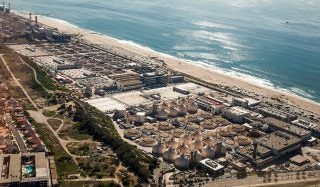Jul 30 2019
Salt is power. This phrase might seem like alchemy; however, the energy in areas where salty ocean water and freshwater mix could offer a huge source of renewable power.
 The Hyperion Water Reclamation Plant on Santa Monica Bay in Los Angeles is an example of a coastal wastewater treatment operation that could potentially recover energy from the mixing of seawater and treated effluent. (Image credit: Doc Searls/Flickr)
The Hyperion Water Reclamation Plant on Santa Monica Bay in Los Angeles is an example of a coastal wastewater treatment operation that could potentially recover energy from the mixing of seawater and treated effluent. (Image credit: Doc Searls/Flickr)
Stanford scientists have created an inexpensive, durable technology that could exploit this so-called blue energy.
The paper, published recently in American Chemical Society’s ACS Omega, explains about the battery and recommends its use to make coastal wastewater treatment plants energy-independent.
Blue energy is an immense and untapped source of renewable energy. Our battery is a major step toward practically capturing that energy without membranes, moving parts or energy input.
Kristian Dubrawski, Study Co-Author and Postdoctoral Scholar, Civil and Environmental Engineering, Stanford University
Dubrawski works in the lab of Craig Criddle, study co-author and a professor of civil and environmental engineering recognized for interdisciplinary field projects of energy-efficient technologies.
The concept of creating a battery that understands salt gradients began with study co-authors Yi Cui, a professor of materials science and engineering, and Mauro Pasta, a postdoctoral scholar in materials science and engineering the research. Implementing that idea in coastal wastewater treatment plants was a twist proposed by Criddle, which originated due to his long experience devising technologies for wastewater treatment.
The scientists tested a prototype of the battery, supervising its energy production while washing it out with alternating hourly exchanges of wastewater effluent from the Palo Alto Regional Water Quality Control Plant and seawater obtained from neighboring Half Moon Bay. For more than 180 cycles, battery materials retained 97% effectiveness in harnessing the salinity gradient energy.
Although the technology could function in any location where fresh and saltwater mingle, wastewater treatment plants provide a particularly important case study. Wastewater treatment is energy-intensive, constituting around 3% of the total U.S. electrical load.
The process—important to community health—is also susceptible to power grid shutdowns. Making wastewater treatment plants energy-independent would reduce electricity consumption and emissions as well as make them resistant to blackouts—the main benefit in areas like California, where recent wildfires have resulted in large-scale outages.
Water Power
Every cubic meter of freshwater that combines with seawater generates around 65 kilowatt-hours of energy—sufficient to power the average American house for almost 30 minutes. The theoretically recoverable energy from coastal wastewater treatment plants across the world is approximately 18 GW—adequate to power over 1,700 homes for a year.
The battery developed by Stanford team is not the first technology to be successful in harvesting blue energy, but it is the first to employ battery electrochemistry rather than membranes or pressure. If it functions at scale, the technology would provide a more straightforward, robust, and cost-effective solution.
The process first discharges sodium and chloride ions from the battery electrodes into the solution, facilitating the current flow from one electrode to the other. After that, a quick exchange of wastewater effluent with seawater causes the electrode to reincorporate sodium and chloride ions and reverse the current flow.
Energy is recovered while flushing the freshwater as well as seawater, without any upfront energy investment and eliminating the need for charging. This implies that the battery is continuously discharging and recharging with no need for energy input.
Durable and Affordable Technology
Although lab tests demonstrated power output to be still low per electrode area, the battery’s scale-up potential is regarded more feasible when compared to prior technologies because of its simplicity, negligible footprint, continuous energy creation, and lack of membranes or instruments to control voltage and charge.
The electrodes are developed with Prussian Blue, a material extensively employed as a pigment and medicine, that costs less than $1 per kg, and polypyrrole, a material employed experimentally in batteries and other devices, which is sold for less than $3 per kg in bulk.
Moreover, backup batteries are not much required, since the materials are comparatively robust, a sulfosuccinic acid and polyvinyl alcohol coating safeguards the electrodes from corrosion, and there are no moving parts involved. If scaled up, the technology could offer sufficient current and voltage for any coastal treatment plant. Excess power production could even be shifted to a neighboring industrial operation, for example, a desalination plant.
“It is a scientifically elegant solution to a complex problem,” Dubrawski said. “It needs to be tested at scale, and it doesn’t address the challenge of tapping blue energy at the global scale—rivers running into the ocean—but it is a good starting point that could spur these advances.”
To evaluate the complete capacity of the battery in municipal wastewater plants, the scientists are working on a scaled version to observe how the system operates with multiple batteries working at the same time.